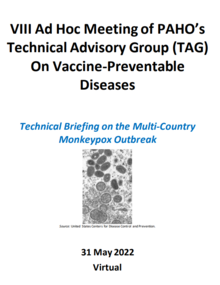Monkeypox virus is an orthopoxvirus that causes a disease with symptoms similar, but less severe, to smallpox. While smallpox was eradicated in 1980, monkeypox continues to occur in countries of Central and West Africa. Two distinct clades are identified: the West African clade and the Congo Basin clade. Monkeypox is a zoonosis. Cases are often found close to tropical rainforests where various animals carry the virus including squirrels, rodents, dormice, and monkeys. Most human monkeypox infections in endemic countries result from a primary animal-to-human transmission. Human-to-human transmission does occur, with the longest documented chain of transmission being six generations. Transmission occurs through contact with bodily fluids, lesions on the skin or on internal mucosal surfaces, such as in the mouth or throat, respiratory droplets, and contaminated objects. Close contact with infected people or contaminated materials should be avoided. While human-to-animal transmission is rare, it should be considered as a possible link in the transmission chain. Monkeypox has been endemic in central and west Africa since its first detection in 1958 in the Democratic Republic of the Congo (1). However, since 13 May 2022 multiple countries in Europe have reported the sudden and unexpected appearance of monkeypox. To date, 27 non-endemic countries across four WHO regions have reported cases. Of these, four are countries in the Americas. Multiple suspected cases in these and other countries are currently under investigation. PAHO's Technical Advisory Group (TAG) on Vaccine-Preventable Diseases met for an ad hoc meeting on 31 May 2022 to discuss the implications for monkeypox in the Region of the Americas. The following report summarizes the epidemiological data to date, reviews available information on monkeypox vaccines, and provides recommendations to Member States of the Americas on how to minimize viral transmission and approach vaccination operations.
|

